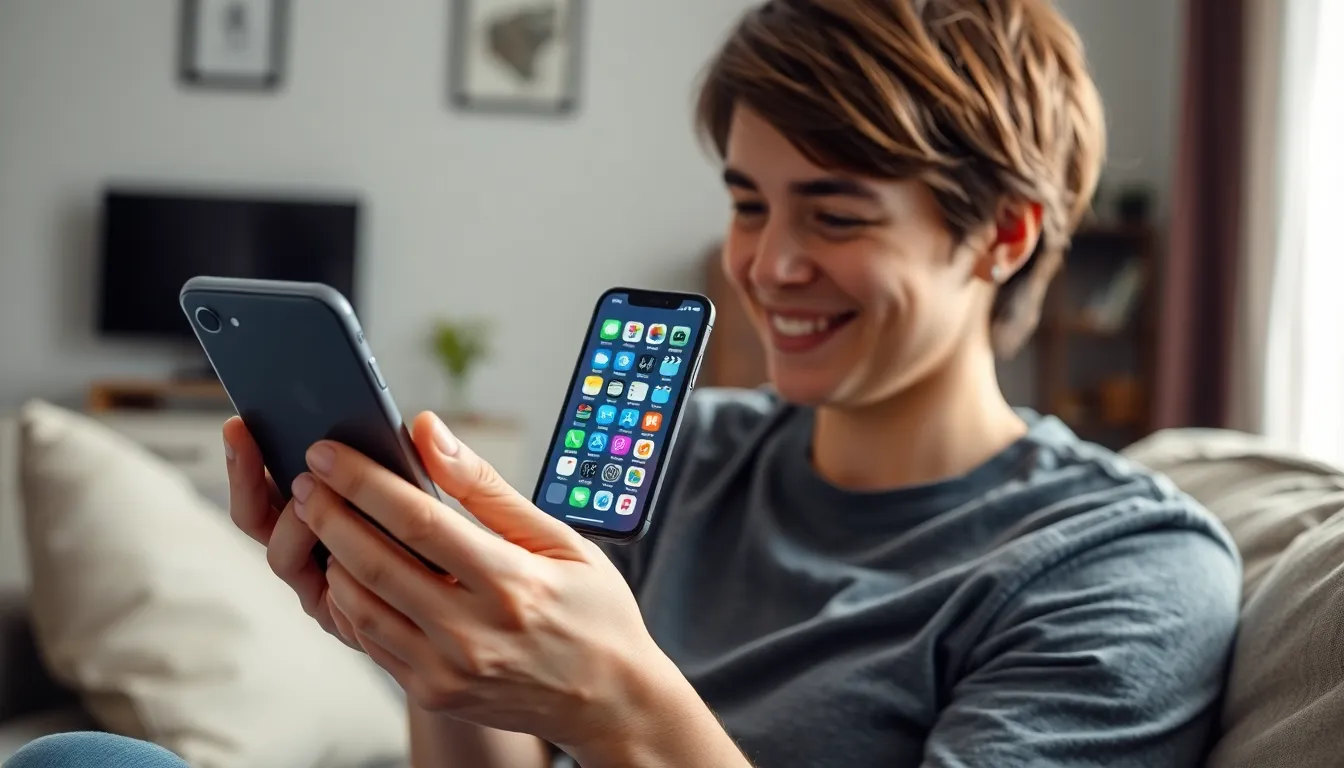Table of Contents
ToggleNavigating an iPhone can feel like a high-stakes game of hide and seek, especially when the elusive home screen seems to vanish into thin air. Whether it’s a rogue app or a stubborn setting, finding your way back can be a bit of a comedy of errors. Fear not, because getting to that familiar grid of apps is easier than finding the last piece of pizza at a party.
Understanding The Home Screen
The home screen serves as the central hub for accessing apps and features on an iPhone. Users encounter a grid of app icons that allow quick navigation. Organizing apps into folders enhances efficiency, making it effortless to locate frequently used applications.
Returning to the home screen often involves pressing the Home button or swiping up from the bottom edge, depending on the iPhone model. When users install new apps, they typically appear on the home screen, ready for instant access. The dock, situated at the bottom of the screen, holds up to four apps for easy reach.
Quickly rearranging app icons helps customize the home screen layout. For instance, dragging an app icon to the desired location and releasing it allows for immediate changes. Such adjustments cater to individual preferences and improve user experience.
Notifications can cluster on the home screen, providing important updates at a glance. By swiping down from the top of the screen, users reveal recent notifications and can interact with them directly. Widgets, introduced in iOS 14, present real-time information, offering an opportunity to personalize the home screen further.
Identifying the home screen might sometimes involve navigating through multiple screens, especially when there are many apps installed. Swiping left or right reveals additional pages. Users can return to the main home screen by tapping the Home button or swiping down from the upper right corner. Following these straightforward steps simplifies the process of accessing the essential interface of the iPhone.
Different Ways To Access The Home Screen

Accessing the home screen on an iPhone is straightforward. Various methods exist for returning to this central hub of app icons.
Using The Home Button
Pressing the Home button provides an instant route to the home screen. This button, located on older iPhone models, offers quick access after navigating apps. Simply tap it, and you’ll find yourself back at the familiar grid of icons. Users can also double-click the Home button to view recently used apps, enhancing multitasking efficiency.
Utilizing Face ID and Touch ID
Face ID and Touch ID serve as instant access points for the home screen. For iPhones equipped with Face ID, a simple glance unlocks the device, returning users to their apps. Touch ID users can unlock their device with a fingerprint tap, making access seamless. These security features speed up the process while maintaining device security.
Swipe Gestures on Newer Models
Using swipe gestures is essential for newer iPhone models without a Home button. Swiping up from the bottom of the screen allows quick navigation back to the home screen. This gesture simplifies the return process and enhances interaction with other apps. Users can also swipe left or right to switch between active apps, streamlining multitasking capabilities.
Troubleshooting Common Issues
Users may encounter obstacles while trying to reach their iPhone’s home screen. Below are common problems and solutions to help resolve them.
Not Responding Touch Screen
A touch screen that isn’t responding can frustrate users. First, try force restarting the device. For iPhones with Face ID, quickly press and release the Volume Up button, then the Volume Down button, and finally press and hold the Side button until the Apple logo appears. For models with a Home button, press and hold the Home and Power buttons simultaneously until the Apple logo shows. Checking for debris on the screen might help, too. Clean it gently with a soft, lint-free cloth. If the problem persists, consider updating the device software. Navigate to Settings, then General, and select Software Update to check for any available updates.
App Malfunctions
Apps can sometimes malfunction, affecting the ability to return to the home screen. Restarting the problematic app often resolves minor glitches. Double-click the Home button or swipe up from the bottom (depending on the model) to access the app switcher, then swipe the app off the screen. Reinstalling the app might be necessary if problems continue. Locate the app on the home screen, press and hold the icon, and select Remove App. After that, visit the App Store to download it again. Users should also ensure their apps are updated. Checking the App Store for available updates can improve performance and functionality.
Tips For Personalizing Your Home Screen
Customizing the iPhone home screen enhances user experience. Adjusting layout preferences provides accessibility to frequently used apps. Users can create folders for better organization; group similar apps together for efficient navigation.
Changing wallpaper adds a personal touch. Selecting unique images from the device’s library or using dynamic wallpapers keeps the aesthetic fresh. Adjusting widget placements on the home screen promotes quick access to information. Effective use of widgets from iOS 14 allows visibility for weather updates, calendar events, or reminders.
Utilizing app library features streamlines access to all installed apps. This option categorizes apps automatically, making searching easier. Users can enable or disable specific pages of the home screen; keeping only essential ones simplifies the navigation experience.
Arranging apps in a grid creates a clean interface. Long-pressing an app icon allows movement to different locations or deleted from the screen. Positioning the most-used apps closer to the dock ensures quick launch capabilities.
Notifications can clutter the home screen; managing them reduces distractions. Adjusting notification settings for individual apps can help prioritize important alerts. Organizing reminders and alarms into specific groups makes access to essential tasks easier.
Exploring options for third-party apps provides additional customization. Many apps offer unique themes or icon packs to refresh appearance. Investing time in personalizing the home screen contributes to a seamless digital experience.
Navigating back to the iPhone home screen doesn’t have to be a daunting task. With the right techniques and understanding of your device’s features users can effortlessly return to their app grid. Whether it’s through simple button presses or swipe gestures it’s all about finding what works best for each model.
Personalization options and organization tips further enhance the experience making it easier to access frequently used apps. By taking the time to customize the home screen users can create a more efficient and enjoyable interface. Embracing these strategies ensures that the home screen remains a reliable hub for all their digital needs.







